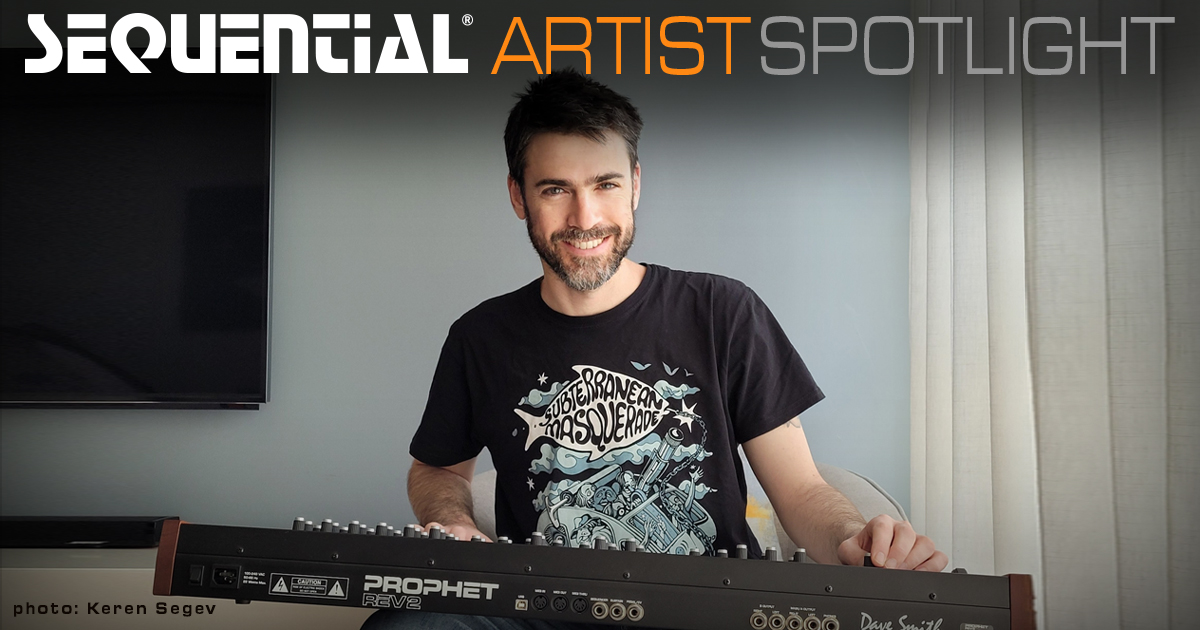
Shai Yallin is a cross-genre keyboard player, composer and producer from Tel Aviv, Israel. Combining influences from his roots in proto-electronic music and progressive rock, he has been making music in his home studio and with bands since the early 2000s. His past work includes keyboards, arrangement and engineering with progressive rock band Solstice Coil, and composition, keyboards, arrangements and engineering with electo rock project Salvya. Currently Shai is active as a solo electronic music artist under the moniker electricmonk, as well as handling keyboards and arrangement duties with Subterranean Masquerade.
We chatted with Shai on how he uses the Prophet Rev2 in his music:
What made you choose the Prophet Rev2?
As a child of the 1980s, I was in love with the sound of synthesizers; I grew up listening to artists such as Jean-Michel Jarre and the radio was almost always playing something synth-laden. When I started playing in bands in my early 20s, I was just starting to seriously learn about synthesis and synth brands, and was bummed to find out that I missed the era of the analog polysynth – in the early 2000s, everything was digital, sample based and cold-sounding. For a while I was a Kurzweil user, and then I moved to a Mac-only setup using MainStage and a MIDI controller. After joining Subterranean Masquerade, I started to add outboard gear to provide our studio albums with a warmer and more realistic sound. Initially I got a Fender Rhodes Mark I, which can be heard on The Great Bazaar and Vagabond. Later, when we wrote Mountain Fever, it became clear that I needed an outboard synth to handle some of the more modern-sounding songs. I had an old Korg DW8000, which was very nice but limited in its sound design potential, and frustrating to program. I knew I wanted an analog polysynth, and I wanted something more powerful than the DW or other polysynths available at the time. The Rev2 seemed like a versatile and capable instrument, so after reviewing some online demos I got myself the 16-voice model.
How are you using it?
Initially I used the Rev2 on Subterranean Masquerade’s Mountain Fever; you can hear it on the title track, as well as on “Ascend”, “For The Leader With Strings Music”, and “Mångata”. I only had it for a few months at the time of recording, so I was mainly using simple patches or presets. Later I got around to recording my solo album under the electricmonk moniker, where it’s used extensively for String Machine sounds, as well as the evolving chaotic pad in “Longing” and the nasty, distorted lead sound in “Chasing Trills”. Right now I’m writing parts for the next Subterranean Masquerade album, which will feature the Rev2 extensively, as well as my new OB-6 Desktop module and the always-evolving Eurorack system.
What is one of your favorite things about it?
Maybe it’s not a popular opinion, but the presets are amazing! Some of them are so good that I use them out of the box, such as the awesome PolyTine (F1 26) which I play as-is, others I tweaked just a tiny little bit, such as the highly-dynamic VeloStrings (F2 01), where I modified the ModWheel to control attack and release time so that I can morph between slow, soaring legato pads and fast staccato passes.
What does it give you that other synths might not?
Recently, I had a special “Analogue Sessions” tour with Subterranean Masquerade, where we played a few intimate dates in a downsized setup; the distorted guitar was swapped for an acoustic one, we lost all backing tracks, and instead of playing a myriad of keyboard instruments using MainStage, I only used my Rev2. And it is here where I truly fell in love with it. During the weeks building towards the first show, I was doing sound-design in real time during our arrangement sessions, creating patches from scratch and iteratively distilling the sound I was looking for, or starting from presets and tweaking it towards what I needed. Eventually I was able to cover both the space left by the backing tracks (string section, horns, etc.) and by the fleet of keyboard instruments (Hammond organ, piano, Rhodes, Mellotrons, synths) using a small bank of about a dozen programs that I used throughout the show.
Any interesting Rev2 tricks or techniques you would like to share?
Sure. I have several:
Any program with a single layer could become bigger and wider by duplicating the layer, stacking both layers, and panning them to opposite sides using the DC modulation source with opposite amounts to control Pan.
Sometimes significant impact could be made by pointing several modulation sources in small amounts to the same parameter (say, filter cutoff); you could combine velocity, pressure and filter envelope, then also modulate the filter envelope amount and/or duration using the velocity and pressure. Use all available mod matrix slots to finely modulate parameters like the filter cutoff, oscillator sloppiness, or the sub oscillator. In essence you’ll be randomizing the sound in minute amounts, yielding results that sound warmer and more alive.
Especially for live situations, prefer a small set of programs that can morph between two extreme variations using the Mod Wheel to a large set of programs you’ll need to navigate between.
Video credits: Sergei Nemichenitser
LINKS
These Odd Times – electricmonk LP
Mountain Fever – Subterranean Masquerade double LP
MORE ABOUT SEQUENTIAL
For more information, check out the Sequential product page here.
Find your local dealer for pricing here.
